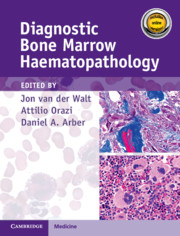Book contents
- Diagnostic Bone Marrow Haematopathology
- Diagnostic Bone Marrow Haematopathology
- Copyright page
- Contents
- Contributors
- Preface
- Acknowledgements
- Chapter 1 The Bone Marrow Biopsy
- Chapter 2 The Normal Bone Marrow
- Chapter 3 Necrosis, Stromal Changes and Artefacts
- Chapter 4 Aplasia
- Chapter 5 Hyperplasia
- Chapter 6 Infective, Granulomatous and Benign Histiocytic Disorders
- Chapter 7 Malignant Disorders of the Histiocytic/Dendritic Lineage
- Chapter 8 Myelodysplastic Syndromes
- Chapter 9 Acute Myeloid Leukaemia
- Chapter 10 Myeloproliferative Neoplasms
- Chapter 11 Myelodysplastic/Myeloproliferative Neoplasms
- Chapter 12 Systemic Mastocytosis
- Chapter 13 Myeloid and Lymphoid Neoplasms Associated with Eosinophilia
- Chapter 14 Precursor Lymphoid Neoplasms
- Chapter 15 Mature Lymphoid Neoplasms
- Chapter 16 Plasma Cell Neoplasia
- Chapter 17 Metastatic Lesions
- Chapter 18 Bone Marrow Changes Following Therapy and Immunosuppression
- Chapter 19 Immunohistochemistry and Flow Cytometry in Bone Marrow Haematopathology
- Chapter 20 Molecular Diagnostics in Bone Marrow Haematopathology
- Index
- References
Chapter 9 - Acute Myeloid Leukaemia
Published online by Cambridge University Press: 12 November 2020
- Diagnostic Bone Marrow Haematopathology
- Diagnostic Bone Marrow Haematopathology
- Copyright page
- Contents
- Contributors
- Preface
- Acknowledgements
- Chapter 1 The Bone Marrow Biopsy
- Chapter 2 The Normal Bone Marrow
- Chapter 3 Necrosis, Stromal Changes and Artefacts
- Chapter 4 Aplasia
- Chapter 5 Hyperplasia
- Chapter 6 Infective, Granulomatous and Benign Histiocytic Disorders
- Chapter 7 Malignant Disorders of the Histiocytic/Dendritic Lineage
- Chapter 8 Myelodysplastic Syndromes
- Chapter 9 Acute Myeloid Leukaemia
- Chapter 10 Myeloproliferative Neoplasms
- Chapter 11 Myelodysplastic/Myeloproliferative Neoplasms
- Chapter 12 Systemic Mastocytosis
- Chapter 13 Myeloid and Lymphoid Neoplasms Associated with Eosinophilia
- Chapter 14 Precursor Lymphoid Neoplasms
- Chapter 15 Mature Lymphoid Neoplasms
- Chapter 16 Plasma Cell Neoplasia
- Chapter 17 Metastatic Lesions
- Chapter 18 Bone Marrow Changes Following Therapy and Immunosuppression
- Chapter 19 Immunohistochemistry and Flow Cytometry in Bone Marrow Haematopathology
- Chapter 20 Molecular Diagnostics in Bone Marrow Haematopathology
- Index
- References
Summary
Acute myeloid leukaemia (AML) is a highly complex and heterogeneous disease. Proper classification according to the 2016 World Health Organization (WHO) classification requires a systematic approach and integration of key clinical, laboratory, pathologic and genetic information [1, 2]. Great advances in our understanding of the pathogenesis and molecular underpinnings of AML have been realized since the original AML classification using the French–American–British (FAB) system (1976). This genetic revolution not only contributes to enhanced disease diagnosis and prognostication but also to ongoing improvements in therapeutic strategies.
- Type
- Chapter
- Information
- Diagnostic Bone Marrow Haematopathology , pp. 127 - 145Publisher: Cambridge University PressPrint publication year: 2021



